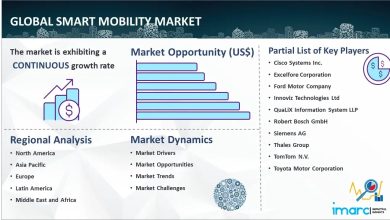Automotive AI market to surge to $19.09B by 2032
Ottawa, April 25, 2024 (GLOBE NEWSWIRE) — The global automotive AI market size accounted for USD 6.32 billion in 2023, it is calculated at USD 7.74 billion in 2024 and is expected to be worth around USD 19.09 billion by 2032, growing at a notable CAGR of 10.55% from 2023 to 2032, according to a study published by Towards Automotive a sister firm of Precedence Research.
The increasing demand for autonomous vehicles worldwide is bolstering the commercial vehicle market, with autonomous vehicles projected to comprise 12% to 17% of all vehicle sales by 2030. Stringent regulations on driving safety are driving OEMs globally to invest significantly in driver assistance systems (ADAS), computer vision, and connected vehicles to enhance vehicle safety and compliance. Growing customer preference for luxury vehicles equipped with advanced driver assistance and automatic driving systems, such as automatic parking and emergency braking, is contributing to market growth.
Ride-sharing and electrification trends are influencing the commercial vehicle market, with AI-driven fleet management and pricing strategies helping to optimize operations and meet demand.
Major technology companies like Intel and Nvidia are actively involved in advancing AI technologies for autonomous vehicles, contributing to the integration of AI into commercial vehicle systems.
China has seen a notable increase in the adoption of AI by OEMs, with the percentage of OEMs using AI rising from 5% to 9% between 2017 and 2018. This growth is attributed to the availability of smart technology through open-source platforms like Baidu’s Apollo, which has partnerships with over 130 companies, facilitating collaboration and innovation in the industry.
Artificial intelligence (AI) is poised to revolutionize the automotive industry by transforming manufacturing processes and driving job growth through technological advancements.
- AI-driven developments are aimed at enhancing passenger traffic and safety within vehicles, with a focus on providing customers with an elevated driving experience and improved ease of operation.
- While AI technology offers features that enhance driving comfort and convenience, it still necessitates the driver’s attention to ensure safe operation.
- The integration of AI in automotive manufacturing processes streamlines production, increases efficiency, and enables innovative solutions that contribute to the industry’s evolution.
- Job growth within the automotive sector is expected to accelerate as AI adoption expands, creating opportunities for skilled professionals in AI development, data analysis, and vehicle technology.
- AI-powered advancements in vehicle safety systems, autonomous driving capabilities, and in-car entertainment enhance the overall driving experience, attracting consumers to AI-enabled vehicles.
Despite the automation and intelligence AI brings to vehicles, drivers remain responsible for maintaining situational awareness and exercising caution while operating AI-equipped vehicles. Driverless vehicles rely on a combination of sensors, including cameras, radar, and lidar, to detect objects such as pedestrians, cyclists, and vehicles on the road. These sensors collect data about the surrounding environment and measure the speed and distance of objects to make informed decisions about driving maneuvers. However, adverse weather conditions such as snow, fog, or heavy rain can significantly impair the effectiveness of these sensors. Driverless vehicles face a challenge with reduced visibility in inclement weather conditions, as it may compromise the accuracy of sensor data, leading to potential safety risks.
The inability of sensors to function optimally in adverse weather conditions can jeopardize driving safety. Driverless vehicles may struggle to accurately perceive and respond to hazards on the road, increasing the risk of accidents. Addressing the challenge of sensor blindness in varying weather conditions is crucial to ensuring the safety and reliability of autonomous driving technology. Despite the challenges posed by sensor blindness, autonomous driving technology holds the potential to revolutionize transportation and improve people’s lives. Autonomous vehicles have the potential to enhance road efficiency, reduce accidents, increase productivity, and minimize negative environmental impacts.
By leveraging advanced AI algorithms and sensor technologies, driverless vehicles aim to offer safer, more efficient, and more convenient transportation options for individuals and communities. Graphics processing units (GPUs) play a significant role in the automotive AI industry, particularly in the development of autonomous driving and advanced driver assistance systems (ADAS). GPUs are essential for processing the vast amounts of sensor data collected by driverless vehicles and making real-time decisions based on that data. Modern cars incorporate GPUs to support digital dashboards featuring high-resolution displays, enabling drivers to visualize maps, forecasts, and other pertinent information while driving. Display technology advancements increasingly rely on GPUs to power higher-resolution screens, making 4K displays more common in luxury and executive vehicles.
Automotive Exhaust Analyzer Market Trends
Shift in Regulations to Drive Growth in Technological Advancements
Significant advancements in artificial intelligence (AI) technologies such as machine learning, computer vision, and natural language processing are pivotal for the automotive industry, enhancing vehicle safety, comfort, and driving experience. AI enables vehicles to better understand their environment and interact seamlessly with it. This ranges from advanced driver assistance systems (ADAS) to autonomous driving capabilities, thereby providing customers with improved and smarter driving experiences.
Partnerships between AI chipmakers like Hailo and technology companies like Renesas Electronics facilitate the integration of AI into automotive systems. This enables the transition from ADAS to autonomous driving. Moreover, the automotive industry uses AI across various facets, including post-production, supply chain management, design, manufacturing, driver support, and measurement. This drives growth in the automotive intelligence sector. Governments worldwide are implementing stringent safety measures. They are also promoting the adoption of AI-powered safety systems such as pedestrian recognition and collision avoidance, further fueling demand for automotive AI solutions.
AI technology optimizes electric vehicle battery life and predicts driving patterns. It also facilitates payment control, contributing to the increasing demand for automotive AI solutions. Regulatory frameworks governing AI-driven technology enhance trust and security in the automotive industry, fostering business growth and innovation. Entrepreneurs must adapt to regulatory requirements to leverage growth opportunities. They must also comply with these regulations to maintain competitiveness in the automotive AI market.
Self-driving cars are categorized based on their level of autonomy, with Level 5 representing vehicles capable of operating without human intervention, while Level 3 and Level 4 vehicles can perform certain tasks autonomously but still require human oversight for safe operation. Leading companies like Google and Uber utilize a combination of sensors, including cameras, radar, lidar, and GPS, to collect data from the vehicle’s environment and enable autonomous driving capabilities. Advanced artificial intelligence (AI) programs process the data collected by sensors. Furthermore, they analyze and predict pedestrian and vehicle movements, enhancing the vehicle’s ability to navigate safely in various driving conditions.
Driverless cars equipped with AI have the potential to address transportation challenges. Particularly in regions with aging populations, they can provide safe and convenient transportation options for elderly and disabled individuals. AI technology enables vehicles to gather information from various sources, including social media and daily behavior patterns. It then personalizes activities and suggests relevant locations or services. Moreover, AI-powered systems in self-driving cars can monitor fuel levels. They can also identify the nearest gas stations or charging stations, enhancing convenience and efficiency for drivers.
Asia-Pacific Is Expected to Be the Leading Market
China, the largest automotive market globally, is embracing artificial intelligence (AI) in the automotive sector. OEMs’ adoption of AI technologies increased from 5% to 9% between 2017 and 2018. Funding for new startups in China’s autonomous driving sector surged. The number of startups receiving funding rose from 8 to 31, representing a remarkable 288% increase from 2014 to 2015. Alibaba has partnered with SAIC to develop connected cars. Baidu has formed partnerships with over 90 companies, including Daimler, through its driverless car support platform Apollo. Moreover, these initiatives showcase China’s commitment to fostering innovation and collaboration in the automotive industry.
China aims to master core technologies by 2025. It also aims to promote the development of smart driving, creating an ecosystem for research, development, production, and usage of smart connected vehicles, signaling its dedication to advancing the automotive sector. Leading automotive companies in China are leveraging AI to enhance customer experiences. One company’s mobile application uses AI to predict optimal transportation options and destinations for users with up to 90% accuracy. Moreover, this indicates a focus on providing convenient and efficient mobility solutions. Chinese automotive firms are expanding internationally, with plans to expand operations to 10 more cities and securing contracts to operate buses in Greece and supply buses to Bangkok, demonstrating the country’s global ambitions and leveraging technological advancements, investments, and strategic partnerships to drive innovation and growth in the automotive industry.
Insight into the Automotive AI Industry
Human-machine interface (HMI) applications are integral to the automotive AI industry as they facilitate communication between drivers/passengers and vehicles. HMIs enable users to interact with vehicles, providing them with convenience, information, and entertainment while on the move. These interfaces are crucial for translating the concept of smart cars into reality. They allow automotive manufacturers to enhance their brand image and deliver innovative experiences to users.
HMIs play a pivotal role in transitioning the smart car concept from theory to practice. They allow automotive companies to implement advanced features and functionalities. Manufacturers can differentiate their brand image by integrating sophisticated HMI systems. Moreover, this allows them to offer unique experiences to users, thereby staying ahead in the competitive automotive market. Advanced features like adaptive cruise control and self-parking create numerous opportunities for automotive HMI systems. These features enhance the overall driving experience and cater to the evolving demands of consumers who seek more convenience and automation in their vehicles.
Machine learning (ML) is a fundamental aspect of automotive AI, enabling vehicles to learn from data and make informed decisions. ML encompasses various learning approaches, including supervised, unsupervised, deep, and reinforcement learning. These approaches empower cars to develop accurate models and recognize patterns effectively. The diverse and rapidly changing nature of data in the automotive industry provides ample opportunities for machine learning to drive innovation and growth. By leveraging ML algorithms, automotive companies can extract valuable insights from data, fueling advancements in vehicle technology, safety, and performance.



